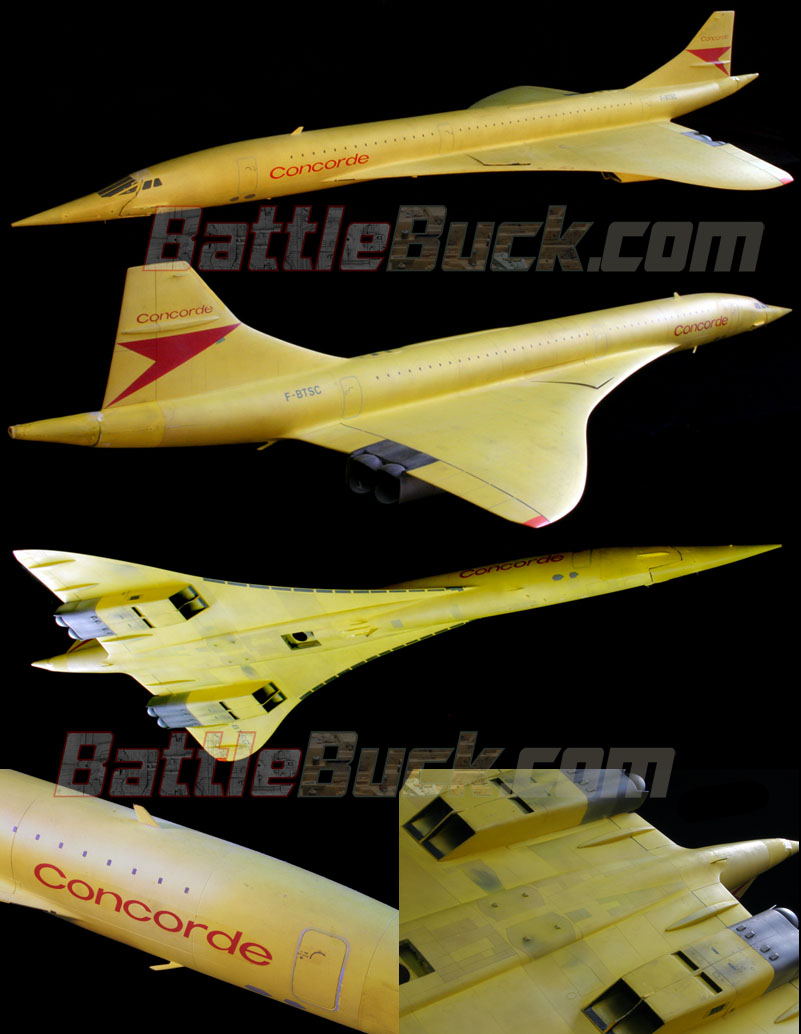
The models on this page were all used in the filming of the visual effects sequences seen in the last movie of the "Airport" series. The VFX were shot at Universal's Hartland facility, and four of the original models are shown here below. All the models were shot using the blue-screen travelling matte technique so common at the time, and the task was made all the more difficult by having to film relatively familiar subjects (aircraft that exist in real life) and matte them into bright sky environments. Video captures of scenes from the film follow the pictures of the models showing how they looked on screen. ConcordeThe Concorde is a model about four feet long, made of fiberglass with scribed panel lines and fine detailing, and is surprizingly heavy. The model is actually painted with a flat yellow finish designed to counteract unwanted reflections in the blue-screen filming process during flight sequences. The yellow paint was "dialed out" during colour correction processing and made to appear white in the final film. It has a full metal armature allowing the model to be mounted from the top, bottom, sides back and front. The hatch on the bottom is shown missing, the side mounts are visible by observing the slightly raised sections on the wings (the model is thirty years old after all!) and the nosecone and tailcone are removable as well to allow the motion control "model mover" rig to plug into the tail. The video captiures below show some of the scenes where this model was used. Note the shot in the top lright corner which betrays the tail mount as a thick cylinder at the rear.  McDonnell Douglas F-4 PhantomBelow we have a couple of F-4 Phantom models that were also used in the blue-screen process. The models are about two feet long and have steel armatures and a fiberglass shell. The grey one was meant to be an enemy fighter sent to shoot down the concorde. The orange one represented the "Harrison Industries unmanned drone" that was seen at the start of the film as target practice. The second picture shows how the model was prepared for filming. Note the removed hatches, held on with magnets, to allow the insertion of rods for the model mover. Note the nosecone could also be replaced with one that allowed the rod to be inserted from the front. The grey one had a vacuformed gloss white canopy made to help show the canopy "glass" reflections in the film. The model's "beauty passes" were shot without the canopy bubble in place against and the bright blue-screen backing. Clear parts are not used during this pass to avoid unwanted reflections called "blue spill". Then, in a separate motion control pass, the mminiature was covered entirely in black fabric and the white canopy in place. The blue screen was substituted with black backing so that the only thing that registers in the pass is the canopy reflection. When the two images were superimposed together, the canopy glass would appear to be in place as shown in the videocaptures from the film below. That kind of work was not possible before motion control systems, which allow frame-by-frame repeatable camera and model moves had been developed.     Dassault-Breguet Mirage F-1Seen only fleetingly in the film, this model of the French-built fighter is about three feet long and represented a pair of Italian fighters sent to destroy the enemy terrorists trying to shoot down the Concorde in the film. Although the model's screen time was severely limited, it is nonetheless a very beautifully detailed model and in near perfect condition after all these years. As with the grey Phantom above, this model was shot without any canopy bubble in place, and the reflection of the canopy was added in a separate motion control pass.  Models photographed and processed exclusively for Battlebuck.com by E. James Small, www.smallartworks.ca Photos may not be re-posted without permission. Video Captures copyright Universal City Studios. |